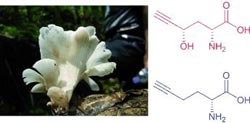Deadly Chinese Mushrooms

Was the consumption of toxic mushrooms responsible for a series of unusual deaths in China’s Yunnan province? A team led by Ji-Kai Liu (Beijing) has now found further proof of this hypothesis. In the journal Angewandte Chemie, the researchers now present two unusual toxic amino acids that they found in extracts from the suspect mushrooms.
Over the last 30 years, more than 260 otherwise perfectly healthy people in Yunnan province in southwestern China died suddenly for no apparent reason. This phenomenon was designated as “sudden unexplained death” and mainly occurred in time- and location-related groupings in the rainy period between June and August in locations between 1800 and 2400 m above sea level.
Epidemiological studies in 2005 proposed that the collection of mushrooms may have been a risk factor; later studies lent weight to the hypothesis that consumption of a previously unknown type of mushroom, which the researchers named “Trogia venenata Zhu L. Yang” for its discoverer, was responsible for the deaths.
The scientists of the Kunming Institute of Botany and the Chinese Center for Disease Control and Prevention have now isolated and characterized three toxic compounds from the fruiting bodies of these mushroom in order to further prove their hypothesis. The compounds include one previously known amino acid, ã-guanidinobutyric acid, as well as two previously unknown and unusual toxic amino acids.
A crude extract from the mushrooms was separated by liquid chromatography and the toxic amino acids were isolated. Various spectroscopic techniques were used to identify their structures. The compounds were then synthesized in the laboratory and compared to the natural products. The two newly discovered amino acids have a terminal ethynyl group in common, a triple bond between two carbon atoms.
The toxicity of the two amino acids was confirmed in trials with mice. In addition, the scientists analyzed a blood sample from one individual who died from “sudden unexplained death” and detected one of the toxic mushroom amino acids.
All previous observations indicate that the mushroom Trogia venenata is the cause for the unexplained deaths. A campaign to warn inhabitants of Yunnan against the consumption of the toxic mushrooms has since been successful: No further cases of “sudden unexplained death” were recorded in 2010 and 2011.
About the Author
Dr Ji-Kai Liu is the Professor of Natural Products Chemitry at KIB as well as the Director of State Key Laboratory for Phytochemistry, and has been working on the medicinal chemistry of higher fungi for over 15 years. He is the recipient of National Award of China.
Author: Ji-Kai Liu, Kunming Institute of Botany (China), mailto:jkliu@mail.kib.ac.cn
Title: Evidence for the Natural Toxins from the Mushroom Trogia venenata as a Cause of Sudden Unexplained Death in Yunnan Province, China
Angewandte Chemie International Edition, Permalink to the article: http://dx.doi.org/10.1002/anie.201106502
Media Contact
More Information:
http://pressroom.angewandte.org.All latest news from the category: Life Sciences and Chemistry
Articles and reports from the Life Sciences and chemistry area deal with applied and basic research into modern biology, chemistry and human medicine.
Valuable information can be found on a range of life sciences fields including bacteriology, biochemistry, bionics, bioinformatics, biophysics, biotechnology, genetics, geobotany, human biology, marine biology, microbiology, molecular biology, cellular biology, zoology, bioinorganic chemistry, microchemistry and environmental chemistry.
Newest articles

“Nanostitches” enable lighter and tougher composite materials
In research that may lead to next-generation airplanes and spacecraft, MIT engineers used carbon nanotubes to prevent cracking in multilayered composites. To save on fuel and reduce aircraft emissions, engineers…

Trash to treasure
Researchers turn metal waste into catalyst for hydrogen. Scientists have found a way to transform metal waste into a highly efficient catalyst to make hydrogen from water, a discovery that…

Real-time detection of infectious disease viruses
… by searching for molecular fingerprinting. A research team consisting of Professor Kyoung-Duck Park and Taeyoung Moon and Huitae Joo, PhD candidates, from the Department of Physics at Pohang University…





















